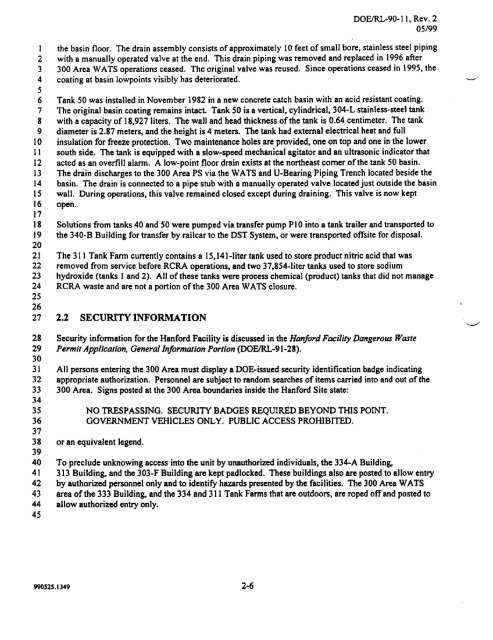View Document Here - Hanford Site
View Document Here - Hanford Site
View Document Here - Hanford Site
Create successful ePaper yourself
Turn your PDF publications into a flip-book with our unique Google optimized e-Paper software.
DOE/RL-90-11, Rev. 2<br />
05/99<br />
1 the basin floor. The drain assembly consists of approximately 10 feet of small bore, stainless steel piping<br />
2 with a manually operated valve at the end. This drain piping was removed and replaced in 1996 after<br />
3 300 Area WATS operations ceased. The original valve was reused. Since operations ceased in 1995, the<br />
4 coating at basin lowpoints visibly has deteriorated.<br />
5<br />
6 Tank 50 was installed in November 1982 in a new concrete catch basin with an acid resistant coating.<br />
7 The original basin coating remains intact. Tank 50 is a vertical, cylindrical, 304-L stainless-steel tank<br />
8 with a capacity of 18,927 liters. The wall and head thickness of the tank is 0.64 centimeter. The tank<br />
9 diameter is 2.87 meters, and the height is 4 meters. The tank had external electrical heat and full<br />
10 insulation for freeze protection. Two maintenance holes are provided, one on top and one in the lower<br />
11 south side. The tank is equipped with a slow-speed mechanical agitator and an ultrasonic indicator that<br />
12 acted as an overfill alarm. A low-point floor drain exists at the northeast comer of the tank 50 basin.<br />
13 The drain discharges to the 300 Area PS via the WATS and U-Bearing Piping Trench located beside the<br />
14 basin. The drain is connected to a pipe stub with a manually operated valve located just outside the basin<br />
15 wall. During operations, this valve remained closed except during draining. This valve is now kept<br />
16 open.<br />
17<br />
18 Solutions from tanks 40 and 50 were pumped via transfer pump P 10 into a tank trailer and transported to<br />
19 the 340-B Building for transfer by railcar to the DST System, or were transported offsite for disposal.<br />
20<br />
21 The 311 Tank Farm currently contains a 15,141-liter tank used to store product nitric acid that was<br />
22 removed from service before RCRA operations, and two 37,854-liter tanks used to store sodium<br />
23 hydroxide (tanks 1 and 2). All of these tanks were process chemical (product) tanks that did not manage<br />
24 RCRA waste and are not a portion of the 300 Area WATS closure.<br />
25<br />
26<br />
27 2.2 SECURITY INFORMATION<br />
28 Security information for the <strong>Hanford</strong> Facility is discussed in the <strong>Hanford</strong> Facility Dangerous Waste<br />
29 Permit Application, General Information Portion (DOE/RL-91-28).<br />
30<br />
31 All persons entering the 300 Area must display a DOE-issued security identification badge indicating<br />
32 appropriate authorization. Personnel are subject to random searches of items carried into and out of the<br />
33 300 Area. Signs posted at the 300 Area boundaries inside the <strong>Hanford</strong> <strong>Site</strong> state:<br />
34<br />
35 NO TRESPASSING. SECURITY BADGES REQUIRED BEYOND THIS POINT.<br />
36 GOVERNMENT VEHICLES ONLY. PUBLIC ACCESS PROHIBITED.<br />
37<br />
38 or an equivalent legend.<br />
39<br />
40 To preclude unknowing access into the unit by unauthorized individuals, the 334-A Building,<br />
41 313 Building, and the 303-F Building are kept padlocked. These buildings also are posted to allow entry<br />
42 by authorized personnel only and to identify hazards presented by the facilities. The 300 Area WATS<br />
43 area of the 333 Building, and the 334 and 311 Tank Farms that are outdoors, are roped off and posted to<br />
44 allow authorized entry only.<br />
45<br />
990525.1349 2-6

















